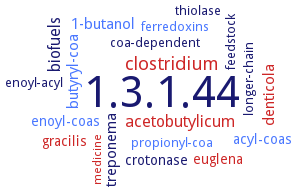1.3.1.44: trans-2-enoyl-CoA reductase (NAD+)
This is an abbreviated version!
For detailed information about trans-2-enoyl-CoA reductase (NAD+), go to the full flat file.

Word Map on EC 1.3.1.44 
-
1.3.1.44
-
clostridium
-
biofuels
-
acetobutylicum
-
treponema
-
denticola
-
1-butanol
-
butyryl-coa
-
crotonase
-
euglena
-
gracilis
-
enoyl-coas
-
acyl-coas
-
thiolase
-
propionyl-coa
-
ferredoxins
-
coa-dependent
-
longer-chain
-
enoyl-acyl
-
feedstock
-
medicine
- 1.3.1.44
- clostridium
-
biofuels
- acetobutylicum
-
treponema
- denticola
- 1-butanol
- butyryl-coa
- crotonase
- euglena
- gracilis
- enoyl-coas
- acyl-coas
-
thiolase
- propionyl-coa
- ferredoxins
-
coa-dependent
-
longer-chain
-
enoyl-acyl
-
feedstock
- medicine
Reaction
Synonyms
2-enoyl-reductase, BatG, CaTER, crotonyl-CoA reductase, NAD-linked, EgTER1, enoyl-acyl carrier protein reductase, ENR, FabI, More, Tde_0597, tdTer, TER, trans-2-enoyl-ACP reductase, trans-2-enoyl-ACP(CoA) reductase, trans-2-enoyl-CoA reductase, trans-2-enoyl-CoA reductase, NADH-dependent, trans-2-enoyl-CoA reductases, trans-enoyl-CoA reductase
ECTree
Advanced search results
Engineering
Engineering on EC 1.3.1.44 - trans-2-enoyl-CoA reductase (NAD+)
Please wait a moment until all data is loaded. This message will disappear when all data is loaded.
F11K
K244A
K245A
Y225A
Y235F
K165A
-
site-directed mutagenesis, mutation of putative catalytic residue
K165Q
-
site-directed mutagenesis, mutation of putative catalytic residue
Y158F
-
site-directed mutagenesis, mutation of putative catalytic residue, mutant can only be stably expressed in Escherichia coli strain BL21(DE3) if altered to a soluble enzyme form dependent on IPTG induction
F295A
mutant shows kinetic behaviour relatively similar to wild-type toward substrates crotonyl-CoA and hexanoyl-CoA
I287A
mutant shows significant decreased kcat values compared to wild-type, mutant exhibit larger increases in catalytic efficiency on the longer hexanoyl-CoA substrate (versus the crotonyl-CoA substrate) of 100 and 17fold compared to that of the wild type (7fold) suggesting suggest these mutations may increase the accessibility of the longer acyl chain to the active site pocket. Mutant shows a much lower Ki (lauroyl-CoA) than wild-type
L276A/V277A
mutant shows significant decreased kcat values compared to wild-type
L276A/V277A/F295A
mutant shows significant decreased kcat values compared to wild-type, mutant exhibit larger increases in catalytic efficiency on the longer hexanoyl-CoA substrate (versus the crotonyl-CoA substrate) of 100 and 17fold compared to that of the wild type (7fold) suggesting suggest these mutations may increase the accessibility of the longer acyl chain to the active site pocket
L291A
mutant shows kinetic behaviour relatively similar to wild-type toward substrates crotonyl-CoA and hexanoyl-CoA
Y240F
Y240F mutation leads to a 5000fold decrease in catalytic efficiency compared to wild-type with no significant change in Km
Y370A
mutant shows kinetic behaviour relatively similar to wild-type toward substrates crotonyl-CoA and hexanoyl-CoA
F295A
-
mutant shows kinetic behaviour relatively similar to wild-type toward substrates crotonyl-CoA and hexanoyl-CoA
-
I287A
-
mutant shows significant decreased kcat values compared to wild-type, mutant exhibit larger increases in catalytic efficiency on the longer hexanoyl-CoA substrate (versus the crotonyl-CoA substrate) of 100 and 17fold compared to that of the wild type (7fold) suggesting suggest these mutations may increase the accessibility of the longer acyl chain to the active site pocket. Mutant shows a much lower Ki (lauroyl-CoA) than wild-type
-
L291A
-
mutant shows kinetic behaviour relatively similar to wild-type toward substrates crotonyl-CoA and hexanoyl-CoA
-
Y240F
-
Y240F mutation leads to a 5000fold decrease in catalytic efficiency compared to wild-type with no significant change in Km
-
Y370A
-
mutant shows kinetic behaviour relatively similar to wild-type toward substrates crotonyl-CoA and hexanoyl-CoA
-
additional information
kcat slightly decreased compared to wild-type, Km (NADH) decreased compared to wild-type
F11K
the mutant shows 198% activity compared to the wild type enzyme
kcat slightly decreased compared to wild-type, Km (NADH) increased compared to wild-type
K245A
the mutant shows 67 activity compared to the wild type enzyme
kcat highly decreased compared to wild-type, Km (NADH) increased compared to wild-type
Y225A
the mutant shows 6.7 activity compared to the wild type enzyme
-
construction of stable mutants for optimization of expression of enzyme in Escherichia coli, absolutely dependent on IPTG, phenotype alterations, overview
additional information
-
generation of a specific in vivo gene inactivation by in-frame deletion of BatG
additional information
-
generation of a specific in vivo gene inactivation by in-frame deletion of BatG
-


 results (
results ( results (
results ( top
top






